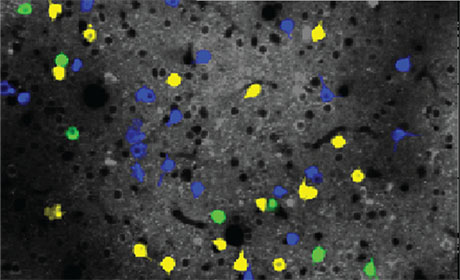

Author: Doug Dollemore
Observing how mouse neurons respond to visual stimuli helps scientists better understand how binocular vision develops. In this image, neurons associated with the left eye (blue), right eye (yellow) and both eyes (green) react as a mouse views moving bars. Credit: Kyle Jenks
For newborn babies, life is just blur. The first few weeks or months of their existence is a mishmash of colors, hazy lights and shadowy shapes. That’s because eyes aren’t quite ready for prime time when we emerge into the world. They need time to mature, refine connections in the brain, and learn how to focus and move in sync.
This synchronization is vital for binocular vision, which allows both eyes to focus on an object so that we see it as singular visual image. Without binocular vision, it’s harder to judge distances or depth, or see an image in 3D. As a result, everyday activities such as catching a ball, driving a car, reading or even walking or running are challenging.
Now scientists at University of Utah Health have found that a gene, called Arc, helps regulate the development of neurons in the brain that are responsible for binocular vision. They say this finding offers key insights into how these cells form and function in the visual cortex, the brain region responsible for processing visual information. More broadly, it reinforces earlier findings that Arc plays a vital role in brain plasticity, the ability to rewire connections between existing neurons or form new ones in response to new behaviors and experiences.
The researchers say better understanding of Arc’s role in this process could foster techniques to improve plasticity in the aging brain and potentially lead to treatments that might improve vision and other vital functions in people who have had strokes or suffered other traumatic brain injuries.
The study appears in the Feb. 11 issue of Cell Reports.
“Brain plasticity is really robust early on in life, but not as an adult,” says Jason. D. Shepherd, Ph.D., the study’s senior author and an associate professor in the U of U Health Department of Neurology and Anatomy. “We think that Arc is a central player in that. If we can tweak this gene in some way to make it work better in adults, we might be able to use it to enhance plasticity in the sensory parts of the aging brain.”
The dramatic way in which the brain changes over time has long captured the imagination of scientists. A “critical window” of brain plasticity explains why certain eye conditions such as lazy eye can be corrected during early childhood but not later in life. The phenomenon has raised the questions: What ordinarily keeps the window open? And, once it’s shut, can plasticity be restored
In previous research, Shepherd determined that Arc rises and falls in parallel with visual plasticity in a mouse visual cortex, peaking in teen mice and falling sharply by middle-age. This correlation suggests that a single gene could help the brain regain some of its youthful potential for learning, remembering and adaptation.
In this new study, Shepherd and graduate student Kyle R. Jenks focused on Arc’s role in the development of binocular vision neurons in the visual cortex. These neurons normally develop after birth. However, young mice placed in a darkened room for long periods of time do not produce binocular neurons, suggesting that experience and learning are needed to trigger the development of these cells.
The researchers used a powerful microscope to observe the real-time development of binocular neurons in young mice exposed to vertical and horizontal bars and other shapes. Then, they disabled or knocked out the Arc gene in these animals, expecting that the mice wouldn’t be able to produce binocular neurons. Instead, they developed more, not less of these cells. More surprisingly, the same experiment in adult mice produced similar results, suggesting that brain plasticity is more enduring than previously thought.
However, the binocular neurons created by these Arc-deficient mice weren’t fully functional and actually could lead to visual impairment, Shepherd says. Based on these findings, the researchers theorize that Arc acts as brake, keeping binocular neurons under control.
“Arc is a bit like Goldilocks, ensuring that there are just the right amount of binocular neurons available in the brain,” Shepherd says. “Without it, you get too many cells that are responding to both eyes and the computational network in the visual cortex is disrupted.”
Understanding how Arc promotes brain plasticity could eventually help those who have suffered strokes or traumatic head injuries, Shepherd says.
“The hard part is recovery. People need, depending on which part of the brain is affected, physiotherapy to reacquire skills,” he says. “We think that kind of relearning process could be bolstered by rekindling plasticity in the brain; activating or deactivating Arc could potentially have a role in that. However, more research is needed to figure out how to therapeutically target Arc-dependent plasticity.”